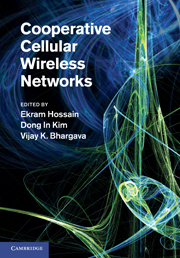Book contents
- Frontmatter
- Contents
- List of contributors
- Preface
- Part I Introduction
- Part II Cooperative base station techniques
- Part III Relay-based cooperative cellular wireless networks
- 6 Distributed space-time block codes
- 7 Collaborative relaying in downlink cellular systems
- 8 Radio resource optimization in cooperative cellular wireless networks
- 9 Adaptive resource allocation in cooperative cellular networks
- 10 Cross-layer scheduling design for cooperative wireless two-way relay networks
- 11 Green communications in cellular networks with fixed relay nodes
- 12 Network coding in relay-based networks
- Part IV Game theoretic models for cooperative cellular wireless networks
- Part V Standardization activities
- Index
12 - Network coding in relay-based networks
from Part III - Relay-based cooperative cellular wireless networks
Published online by Cambridge University Press: 03 May 2011
- Frontmatter
- Contents
- List of contributors
- Preface
- Part I Introduction
- Part II Cooperative base station techniques
- Part III Relay-based cooperative cellular wireless networks
- 6 Distributed space-time block codes
- 7 Collaborative relaying in downlink cellular systems
- 8 Radio resource optimization in cooperative cellular wireless networks
- 9 Adaptive resource allocation in cooperative cellular networks
- 10 Cross-layer scheduling design for cooperative wireless two-way relay networks
- 11 Green communications in cellular networks with fixed relay nodes
- 12 Network coding in relay-based networks
- Part IV Game theoretic models for cooperative cellular wireless networks
- Part V Standardization activities
- Index
Summary
Introduction
Since its inception in information theory, network coding has attracted a significant amount of research attention. After theoretical explorations in wired networks, the use of network coding in wireless networks to improve throughput has been widely recognized. In this chapter, we present a survey of advances in relay-based cellular networks with network coding. We begin with an introduction to network coding theory with a focus on wireless networks. We discuss various network coded cooperation schemes that apply network coding on digital bits of packets or channel codes in terms of, for example, outage probability and diversity–multiplexing tradeoff. We also consider physical-layer network coding which operates on the electromagnetic waves and its application in relay-based networks. Then we take a networking perspective, and present in detail some scheduling and resource allocation algorithms to improve throughput using network coding in relay-based networks with a cross-layer perspective. Finally, we conclude the chapter with an outlook into future developments.
Network coding was first proposed in for noiseless wireline communication networks to achieve the multicast capacity of the underlying network graph. The essential idea of network coding is to allow coding capability at network nodes (routers, relays, etc.) in exchange for capacity gain, i.e., an alternative tradeoff between computation and communication. This can be understood by considering the classic “butterfly” network example. In Figure 12.1, suppose the source S wants to multicast two bits a and b to two sinks D1 and D2 simultaneously.
- Type
- Chapter
- Information
- Cooperative Cellular Wireless Networks , pp. 324 - 344Publisher: Cambridge University PressPrint publication year: 2011



